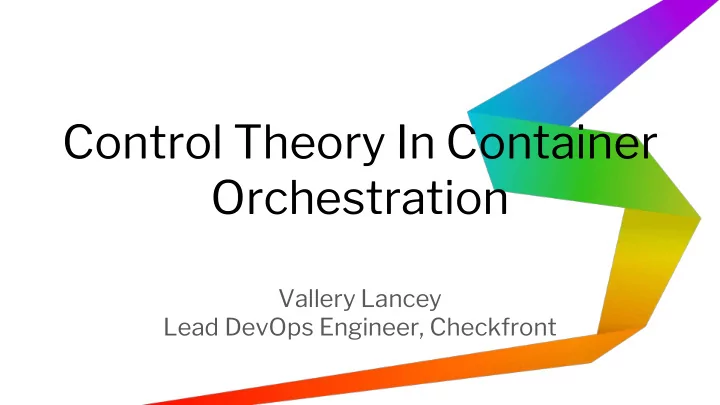

Control Theory In Container Orchestration Vallery Lancey Lead DevOps Engineer, Checkfront
Container Orchestration Fundamentals @vllry
Goals of Container Management Reproducibility. ● Cohabitation. ● Auto-management of instances. ● @vllry
System Management Traditional: a sysadmin Automatic: the system tracks examines the system, makes a its own state, and translates judgement, and performs an the state to some internal action. action. @vllry
Key Auto-Management Features Allocate appropriate resources. ● Manage network based on container health & state. ● Reap unhealthy containers. ● Maintain container headcount. ● Auto-scale container groups. ● @vllry
Control Theory @vllry
What is Control Theory? Engineering topic: how to manage a system using human and ● internal controls. Used heavily in... ● Physical device design ○ Plant/factory management ○ Electrical engineering ○ @vllry
A Controller Inputs dictate what the controller should do (setpoint). ● Outputs dictate what the controlled process should do. ● @vllry
Open Loop Controllers A controller with only inputs and outputs is an open loop ● controller. Can’t respond to feedback from the controlled process. ● @vllry
Closed Loop Controller Contains feedback from the process to the controller. ● The controller is able to self-correct to achieve the desired ● outcome. @vllry
@vllry
The Math is Unfortunate Control theory is split into linear (PV changes linearly with ● control) and nonlinear problems. Most of our problems are nonlinear. ● Nonlinear problems have fewer known methods, and are often ● reduced to simplified linear problems. @vllry
Applying Control Theory To Containers @vllry
t while True { n i o p t e S currentState = getCurrentState() desiredState = getDesiredState() Process Variable makeConform(currentState, desiredState) } @vllry
Container Lifecycle: Readiness Probe When a container is launched, we don’t want to serve it traffic ● before it’s ready. A readiness probe uses some “OK” response (EG HTTP 200) to ● decide when. What do we need to build this? ● Container lifecycle status ○ Probe destination ○ Probe behaviour config ○ @vllry
@vllry
@vllry
@vllry
@vllry
@vllry
Replica Headcount How do we ensure the right number of container copies exist? ● Need to maintain the desired replica count ( input ). ● Need to check the current number of containers ( feedback ). ● Need to create or terminate containers accordingly ( output ). ● @vllry
Replication Controller @vllry
@vllry
Autoscaling @vllry
Autoscaling Deployments Need to track a specified metric (CPU use, network I/O, etc). ● Need to increase or decrease replicas if the metric is ● sufficiently above or below the target. Should respond quickly and without overcompensating . ● @vllry
Bang-Bang Controller Controller with upper and lower bounds, where the set point is ● never exactly met. Process is turned on when one extreme is hit, and turns off ● when the other is hit. @vllry
@vllry
@vllry
Challenges in Designing a Controller Accepting a “close enough” error, rather than thrashing. ● Responding quickly without overcompensating. ● Predict the right replica setpoint. ○ Account for the delay in SP->PV propagation. ○ @vllry
Delayed Response @vllry
Bootup Time Containers take time to boot (surprise!) ● Resource allocation. ○ Image pull & app startup. ○ @vllry
@vllry
@vllry
Accounting for the Delay Must guess if no context. ● Can wait out the grace period, or... ○ Can define some % of the grace period to overscale after. ○ Custom controllers can allow context. ● Can have a statistical explanation of boot time. ○ Can use a custom readiness probe that shows progress (whitebox). ○ @vllry
Matching Demand @vllry
Scale Ramp-Up Scaling up quickly is especially important. ● Typical controller approaches: ● Immediately add enough replicas to satisfy load/replicas for ○ current load. Keep scaling up each loop, until satisfied. ○ Can we keep scaling both fast and precise? ● @vllry
@vllry
@vllry
PID: Proportional The proportional component is a linear response to the magnitude of the error. @vllry
PID: Integral The integral component is a compensator . It responds to the magnitude and duration of the error. @vllry
PID: Derivative The derivative component is a predictor of the future error, based on the trend of the current error. @vllry
PID Controllers Use the proportional , integral , and derivative components to ● react , compensate , and predict for required output. Each component is tuned using a constant. ● @vllry
Autoscaling With a PID Controller Proportional and integral components drive scaling. ● Integral and derivative components increase scale speed, at the ● cost of overcompensating. Derivative is “less accurate” but can help in sharp raises/drops. ● @vllry
Autoscaling in Kubernetes Kubernetes uses a proportional controller (with a lot of checks ● and balances. Prioritizes gradual resolution over unstable resolution. ● Scaling (Horizontal Pod Autoscaler) updates Deployment spec - ● doesn’t touch pods itself. @vllry
In Summary Ensure any controller has the necessary feedback to properly ● achieve its outcome. Strictly define expectations of any controller. ● Build discrete, transparent, and testable controllers. ● Ensure shared state has a single source (CP). ● Custom controllers are common based on app behaviour and ● expectations. @vllry
Oh Yeah, Hi! I’m a software/systems person ● at Checkfront (online bookings) I work with Kubernetes & “cloud ● stuff”. @vllry
Thank You! Brian Liles & coordinators & staff Joe Beda Tim St. Clair @vllry
Audience Questions @vllry @vllry
Recommend
More recommend